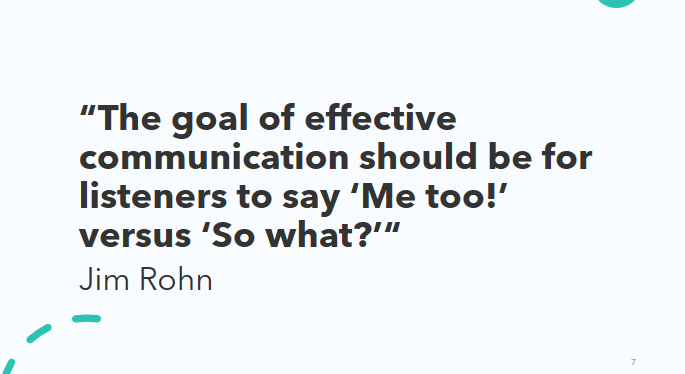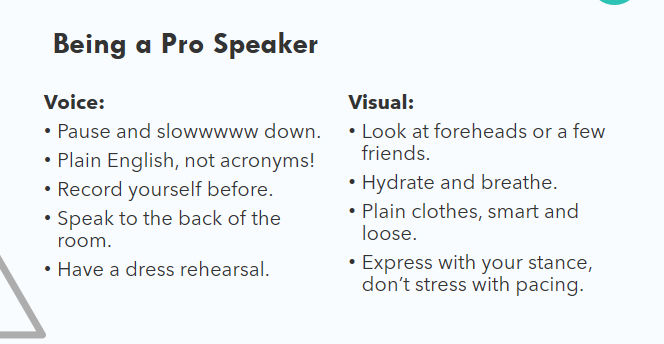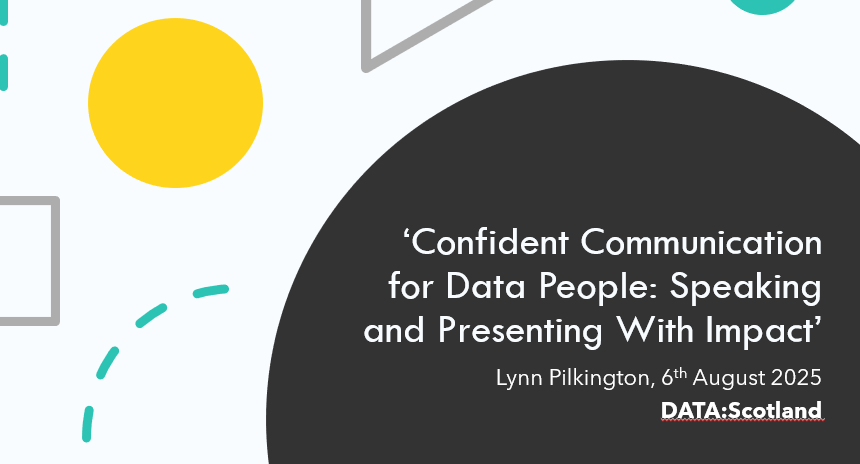Confident Communication for Data People: Speaking and Presenting With Impact
Born For Stage
The cassette karaoke machine was blasting, ‘I Should Be So Lucky’, in the living room and I was singing my 8-year-old heart out. My family was gathered for, yet another, performance. I started out as a confident young woman, comfortable with a mic in my hand, and this has been a running theme in my life. My stage credits include: two decades of dancing displays, countless times being cast as the ‘narrator’ in school shows, winning a speech contest and Burns competition, two pantomime performances, regular spoken word performances in my twenties and winning a poetry slam in London, writing and performing a theatre show and being front-line-chorus in productions of Guys and Dolls and Little Shop Of Horror.
I now regularly do public speaking professionally and presenting to the room is the easiest part of my day. Everyone in the room paying attention to me talking about my favourite subject? Yes, please I’d love to!
However, as someone who used to work in tech and who still enjoys working on digital projects, I recognise that the typical tech employee does not share my natural enthusiasm for the stage. Often my dev peers are much happier quietly typing being a screen rather than being the centre of attention. Which makes them incredible at finishing ‘tickets’. However, presenting and speaking is a crucial skill in the modern workplace as it enhances communication, leadership, and career advancement. Mastering public speaking also positively impacts on your ability to influence, persuade, and build strong professional relationships.
Screenshot of slide with various photos of Lynn performing.
Connecting With Your Audience
This year I was delighted to assist Data Scotland in mentoring and training their new speakers in preparing for their conference sessions. I have been in plenty of situations where information about data has been met with drooping eyes and a switched off crowd. Not because data is not important – it really is. Sometimes the information does not have the intended impact because the audience is left thinking, ‘So What?’. That’s why last year, after attending the Data Scotland conference and talking to multiple people about the frustrations they have about getting others on board with their work, I wrote a blog post, ‘How to convince other people that your data is interesting’.
Connection plays the crucial part of working with an audience. As Jim Rohn says, “The goal of effective communication should be for listeners to say ‘Me too!’ versus ‘So what?’“. Coming back to this intent keeps the content on track. When opening a session, the speaker can gain immediate buy-in by identifying the problem that their talk will solve. This immediately grounds the topic in a real-world problem.
Screenshot of slide with quote from Jim Rohn.
Storytelling For Impact and Confidence From Competence
Being guided by real-world-problems to solve is a great guide for bringing any technical subject to life. When preparing for a session, draw regularly on diagrams and demos to show your work in action. People can connect their experiences more concretely to this over abstract data. Storytelling techniques can be drawn upon with great effect, such as having a beginning, middle and end, using personal stories throughout, drawing on emotion and finishing with a call to action. Taking the time to reflect on creative ways to communicate your complex topic will significantly increase your impact. If you are looking for examples of how I have done this in the past for different audiences, check out my blog posts on speaking engagements and my past projects in my portfolio.
Regarding your slide deck that accompanies your topic, I always keep things quite light and use the structure to keep me on track. Some photos with humans help to make the topic more engaging and I’d always recommend to use the accessibility checker to check that the information is as clear as possible. Try to ensure that data and graphs communicate your message clearly, rather than simply clutter your slides.
In any public engagement, confidence comes from the competence that you have in the subject, along with the assurance that you are well-prepared. Having slides backed-up, along with a point of contact for any technical glitches, ensures that you are prepared for whatever occurs. Welcoming audience members into your session with a smile tells them, ‘You belong here. We’re going to make this topic interesting for you’. Nerves are to be expected; but you can welcome them too, thanking them for showing you how important this situation is.
Screenshot of slide with presentation visual and verbal tips.
Presenting Like a Pro and Sharing on Socials
As for presenting itself, make a conscious effort to have relaxed and open body language. Try to not nervously move around and take a regular pause to breathe. Your speaking style will be honed with practice – so keep practicing! Record yourself and listen to it back to find and glitchy bits or parts that need to be slowed down. Speak clearly and project to those at the back of the room – they want to stay engaged too! Looking at a few faces throughout aids with connection. I’d recommend doing visualisations beforehand where you are presenting with ease and feeling relaxed and happy. When going ‘live’, draw on these memories and let them play out in real life.
And, last tip but a biggie for the modern world, remember to share your work after the session. Package your lessons in a blog post (like this!) and have the slides available for download. Remember to get a peer to take a few action shots, which have good lighting, which will look great on socials.
And that’s a wrap! Hopefully the above tips will aid you in the lead-up to your speaking engagement. Well done for putting yourself out there! I’ll be cheering for you…. And maybe you’ll be tempted to join a musical theatre production with me soon? (haha maybe not!).
If you want a copy on the slides, click on the image below.



